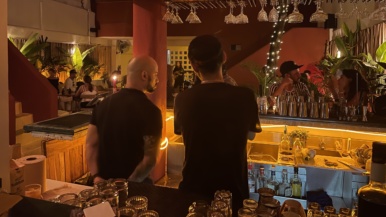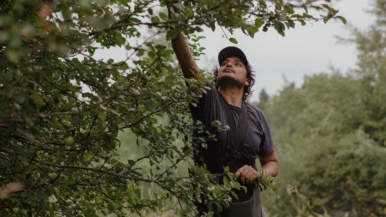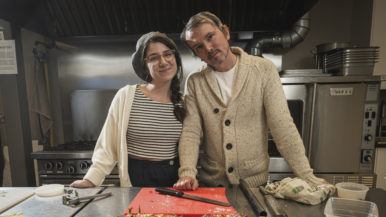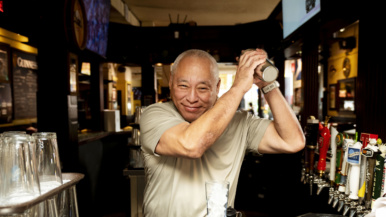We planned to adopt a toddler, but ended up with a 17-year-old

My husband, Peter, and I married in 1995. We had an informal agreement that we’d have two biological children, then adopt two more, but life didn’t work out that way. Instead, I had four babies in nine years. Our big family was exhausting, exhilarating and expensive, and I loved (almost) every minute of it. But, when our youngest son turned three, I realized it was time to plunge into my adoption dream or let go of it.
People called us crazy—we had four rambunctious boys under the age of 11 and we planned to adopt a toddler—but we were determined. When we discovered we’d be at the bottom of a five-year waiting list for international adoption, we tried the Adoption Resource Exchange. It’s an event hosted by the Ministry of Children and Youth Services. Children’s Aid Society workers from across the province gather to try to find homes for hard-to-place kids: sibling groups, children with disabilities, teens. It’s heartbreaking. There are files and files of children who will likely never get placed.
I believe family is a basic human right, and visiting the exchange clinched it for me. I thought, Why not adopt a teen? We could provide a teenager with love and opportunities. Plus: no toilet training! No schlepping a stroller all over the city! One of my sons once asked me why I wanted to adopt. “Mom,” he said, “our family is crazy and loud and annoying, right? Why make it even more crazy, loud and annoying?” But I knew that, if I could give a kid a chance at a family, I had to try.
One evening, we got an email from our caseworker. It read like something off a dating app: “teen new-comer from Asia, likes school and playing piano, seeks family.” She was 16—much older than we’d ever imagined. “This teen would benefit from a very nurturing, loving mom who is demonstrative with affection,” the note read. A few weeks later, we met with her adoption worker and foster mom, who told us how resourceful and creative the girl was, and how she dreamed of attending university to study art. I thought, This could be our daughter.
We met her at FunWalk, an annual fundraiser for the Adoption Council of Ontario in Riverdale Park. I was incredibly nervous. I wanted her to want our family as much as we wanted her. She was tiny and adorable, not even five feet tall and less than 100 pounds, dressed in leggings and an oversized hoodie. I talked and talked and talked—and she nodded a lot. She didn’t speak much English then, but she bonded with my sons over a mutual love of candy. The FunWalk is like an old-timey fair: every time you play a game, you get candy. They went from booth to booth, stuffing their pockets—and faces—with sweets. Turns out, candy is a universal language.
After that, she stayed with us every weekend for a month. She was reserved, but we knew she was interested because she kept saying yes: yes to weekend visits, yes to help with her homework, yes to a road trip to Ottawa. We texted constantly. Because of the language barrier, our early chats were mostly strings of emojis: happy faces, dogs, cats. At night, she stayed up with Peter and me, and painted our nails with nail art. Whenever she left, our house felt empty.
In October, she told us she wanted to be our daughter. CAS hired an interpreter who could explain the full legal process, right down to whether she wanted to call us “Mom” and “Dad.” (She did.) A couple of months later, we celebrated Hanukkah, and I finally realized how much we meant to her. When she arrived for dinner, she brought presents for all of us. She bought pencil cases and notebooks for her brothers, and she got me a necklace with two silver charms: a little girl and a heart. I burst into tears.
She moved in full time on January 25, 2013, when she was 17. We transformed her room, painting the walls yellow and plastering them with giant flower-shaped stickers. It was bright, cheery and so quintessentially teen girl. She was ecstatic to have a room that was hers.
It’s amazing to live with someone who has chosen to be part of your family. There are roughly 6,500 kids in foster care in Ontario, and the year we found our daughter, only three other kids over the age of 16 were adopted. Adopting an older child is incredibly rewarding. We got our dog, Kora, after our daughter moved in so we could build new experiences as a family. We introduced her to skiing. And, not long after we adopted her, she chose to convert to Judaism. The whole thing was her idea. She went through a Reform conversion—she’s so small that I thought she’d drown in the mikveh.
I remember one morning, soon after she moved in, I woke up and her room was empty. I thought, That’s it. She’s gone. I bolted through the house, thinking she had run away. I found her in the basement doing homework—she hadn’t wanted to wake us. I don’t worry like that anymore. She’s finishing her first year at OCADU while still living at home with us. And it feels as though she’s always been here.
Aviva Zukerman Schure works for the Adoption Council of Ontario.
Email submissions to memoir@torontolife.com





